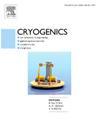Development and application of a measurement system for effective thermal conductivity in cryocooler regenerators
IF 2.1
3区 工程技术
Q3 PHYSICS, APPLIED
引用次数: 0
Abstract
In regenerative cryocoolers, the regenerator is composed of stacked layers of the regenerator material in the form of wire meshes or spheres, and the voids of the regenerator are filled with a working fluid, such as helium gas. Thermal conduction loss occurs in the regenerator because of the large temperature difference between its hot and cold sides. It is important to develop a high-efficiency cryocooler to estimate accurately thermal conduction loss. However, it is difficult to estimate the effective thermal conductivity of these complex structures. Therefore, in this study, we developed a new effective thermal conductivity measurement system that can emulate the operating environment of a cryocooler. The soundness of the developed system was confirmed by measuring the thermal conductivity of SUS304. We also measured the thermal conductivities of stacked lead alloy spheres and zinc spheres, and the voids of the stacks were filled with helium gas, which is a typical regenerator for cryocoolers. Measurements were performed in the temperature range of 5–50 K and the pressure range of 0.5–2.5 MPa. A regression analysis revealed that effective thermal conductivity of regenerator was only dependent on the thermal conductivity of the helium gas.
制冷机蓄热器有效导热系数测量系统的研制与应用
在蓄热式制冷机中,蓄热器由以钢丝网或球体形式堆叠的蓄热器材料层组成,并且蓄热器的空隙充满工作流体,例如氦气。由于蓄热器冷热侧温差较大,蓄热器内部会发生导热损失。为了准确估计热传导损失,研制高效制冷机具有重要意义。然而,很难估计这些复杂结构的有效导热系数。因此,在本研究中,我们开发了一种新的有效的导热系数测量系统,可以模拟制冷机的工作环境。通过测量SUS304的导热系数,验证了所开发体系的有效性。我们还测量了堆积的铅合金球和锌球的导热系数,并在堆的空隙中填充氦气,这是一种典型的低温冷却器再生器。测量温度范围为5-50 K,压力范围为0.5-2.5 MPa。回归分析表明,蓄热器的有效导热系数仅与氦气的导热系数有关。
本文章由计算机程序翻译,如有差异,请以英文原文为准。
求助全文
约1分钟内获得全文
求助全文
来源期刊

Cryogenics
物理-热力学
CiteScore
3.80
自引率
9.50%
发文量
0
审稿时长
2.1 months
期刊介绍:
Cryogenics is the world''s leading journal focusing on all aspects of cryoengineering and cryogenics. Papers published in Cryogenics cover a wide variety of subjects in low temperature engineering and research. Among the areas covered are:
- Applications of superconductivity: magnets, electronics, devices
- Superconductors and their properties
- Properties of materials: metals, alloys, composites, polymers, insulations
- New applications of cryogenic technology to processes, devices, machinery
- Refrigeration and liquefaction technology
- Thermodynamics
- Fluid properties and fluid mechanics
- Heat transfer
- Thermometry and measurement science
- Cryogenics in medicine
- Cryoelectronics
 求助内容:
求助内容: 应助结果提醒方式:
应助结果提醒方式:


